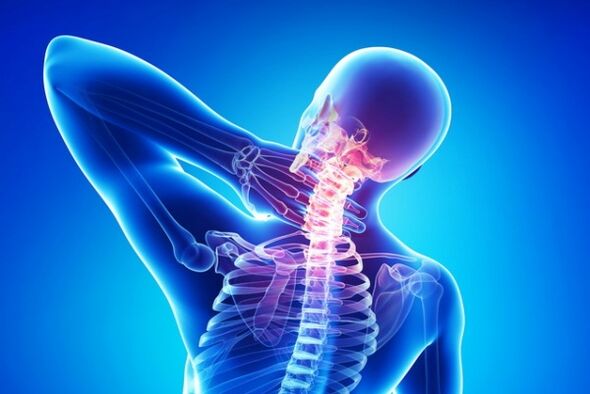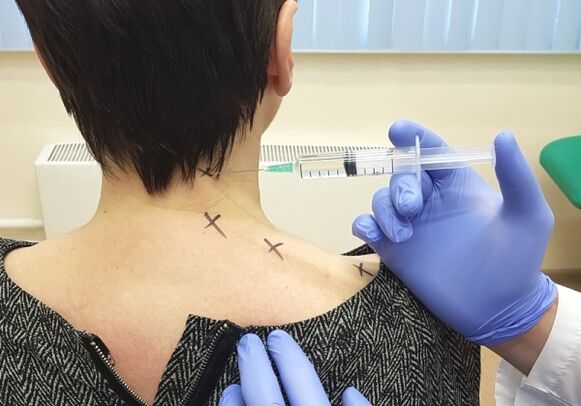Osteocartilage degeneration in the cervical vertebra is a common osteocartilage variant. It is manifested by degenerative destruction of the intervertebral disc and adjacent vertebrae. At the same time, the arteries and nerve ends are attracted to the pathological process. Recently, cervical osteochondrosis has become much younger. If this disease was a lot of older people in the last century, then today, young people aged 23-40 may suffer from age losses. This malnutrition accounts for 40% of the total number of patients.

reason
Why does cervical osteochondrosis develop? It turns out that the most common cause of pathology is the lack of active exercise. Sitting with your neck stretches forward or bows – this is the workday for office staff and many other professional representatives. Most people come home and sit on their computers or TV again. Similar lifestyles lead to worsening blood flow in spinal arteries, followed by malnutrition of intervertebral discs and destruction of vertebrae. The factors considered are far from the only culprit of the disease. There are other causes of cervical osteochondrosis. For example, many experts are very important for hypothermia and the genetic weaknesses of the intervertebral muscles, ligaments and muscles. The following factors become the starting mechanism for the development of cervical osteochondrosis:
- Diseases in the work of the endocrine system;
- Flat feet
- Spine injury;
- Violation of posture;
- Diet imbalanced;
- High load on the cervical segment;
- autoimmune diseases;
- Virus and infection.
In women in postmenopausal women, progressive malnutrition in cervical spine is caused by a decrease in estrogen production, accompanied by the development of osteoporosis.
symptom
Symptoms of osteochondrosis can occur at the beginning of the disease and in the chronic stage. It all depends on the degree of malnutrition, accompanied by the combination of pathology and adverse conditions. The main symptoms of cervical osteochondrosis:
- Bench hell;
- Migraine, dizziness;
- Neurotic disease;
- pain and tightness in the neck;
- Weaknesses of upper limbs:
- Impaired sensitivity;
- hearing and vision worsen, confusion in motor coordination;
- Loss of performance.
The pain of cervical osteochondrosis can be anywhere - shoulders, elbows, ears under the shoulder blade. The unique characteristics of unpleasant feelings are surprising. In acute attack, discomfort and accidents that occur disappear. Dizziness in neck osteocartilage degeneration is usually accompanied by disorientation, ears sound, loss of consciousness, nausea, and migraine. The stress surge occurs several times a day and is not effective with the help of medical corrections. Symptoms of cervical spine damage that occurs in the brain are based on worsening blood flow and tissue nutrients. Due to compression of the patient's spinal cord artery and oxygen starvation, the following diseases are manifested:
- fear and panic;
- Irritable;
- invasion;
- Frequent emotional changes;
- Tears
- Insomnia;
- deterioration of memory and attention;
- Unreasonable anger erupted.
Signs of cervical osteochondrosis in women appear to be earlier than men and more obvious. Usually, the first symptom of a disease is a brain disease, usually written off on PMS or hormone failure. Then there is dizziness, migraine, and loss of consciousness. Symptoms of cervical osteochondrosis in men do not occur so strongly and are usually similar to attacks of angina, shortness of breath, nausea, discomfort behind the sternum. Only the expert can determine the real reason for this manifestation, and he will be able to provide the main help, so he should not delay access.
degree
To consider and analyze changes in vertebral tissue, doctors specify several stages of osteochondrosis in the cervical vertebrae region:
- Clinical stage. The first degree of cervical osteochondrosis is expressed by displacement of the plasmon to the lateral surface and the beginning of fibrous annulus damage. During this period, pain may not exist and may be difficult in small vertebrates turning or tilting the head.
- Osteochondrosis in the second degree of cervical area is characterized by increased pathological destruction, instability throughout the segment, and pain in subluxis, sometimes radiating in the shoulder straps or arms. Patients complain about distraction, memory and attention deterioration.
- The fibrous annulus completely ruptures to form osteocartilage of 3 degrees. Neurological symptoms appear and sensitivity is disturbed. The third stage of pain becomes persistent and plagues the patient. The activity of the neck is worsened.
- Osteochondrosis on the neck is 4 degrees. The final stage of the degradation process. The disc is completely replaced by connective tissue, and all symptoms become more obvious, the coordination of movement becomes worse, and ataxia.

According to the location of the pain, the following types of diseases are distinguished: the cervix. Of course, according to this method, the disease habit is divided into acute vertebrae and osteocartilage of the neck, which first appeared and long-term, and has been ongoing for many years and has been continuously recovered and intensified.
Which doctor treats cervical osteochondrosis?
Various symptoms usually hidden under the mask of another disease can cause a logical question for the patient - which doctor should I contact? When there is any pain in the neck, shoulders and hands, or neurological disorders, it is urgent to approach a neurologist. If there is no such expert in the local clinic, who can I contact? In this case, the ticket should be postponed to the therapist. Doctors will prescribe treatment or send narrow specializations to their doctors.
diagnosis
The diagnosis of cervical osteochondrosis begins with visual examination and investigation of the patient. Neuropathologists are interested in the patient's life and labor status, chronic diseases, nutrition and exercise activities. The preliminary diagnosis was confirmed by the conduct of instrumentation studies:
- X-rays made two predictions;
- MRI;
- CT;
- Duplex scanning.
A more fairer gender requires hormone analysis. Without it, the treatment of cervical osteochondrosis in women cannot begin. To rule out the pathology of this symptom, differential diagnosis is made by additional consultation with surgeons, gynecologists, cardiologists, ophthalmologists, and knowledge.
treat
First aid for acute cervical segment pain involves anesthesia and ensuring the remaining affected areas. Distraction therapy - Pepper, applying heated ointment helps. However, such measures cannot cope with the disease. They only temporarily promote the patient's condition. The treatment of cervical vertebrae bone marrow disease is comprehensive. Its main goal is to eliminate pain and slow down the damage to the disc and vertebrae. To this end, various types of therapies are specified: medication, exercise therapy, massage, wearing orthopedic collars. Treatment of cervical osteochondrosis in women has many characteristics, mainly to eliminate symptoms that occur in the brain. Another effective treatment for neck pain is physical therapy. Prescribe treatment during aggravation and relief. The following procedures deal with symptoms of osteochondrosis:
- laser;
- Magnetic therapy;
- ultrasound;
- Electrophoresis with Novocaine or Eufillin.
Markly promotes the condition of patients with therapeutic massage. Only during the remission phase. To achieve sustained results, treatment was performed through a course consisting of 9-10 procedures. Rehabilitation gymnastics are very effective for osteochondrosis in the cervical vertebrae. The load at stringent doses quickly eliminates discomfort, improves vertebrae mobility, strengthens muscles and enhances blood flow. Patients with osteochondrosis often turn to traditional medical recipes in hopes of cure. It should be remembered that all non-traditional agents are only supplemented with the primary therapies prescribed by the doctor. Can cervical osteochondral disease be completely cured? Unfortunately not. Drugs and other conservative methods can only pause the malnutrition process and eliminate symptoms. Even after satisfactory treatment, the affected disc is replaced by connective tissue and loses its function.
complication
Osteochondrosis in the cervical spine has the risk of complications. As the disease progresses adversely, squeezing the spinal arteries may lead to stroke in the brain, and continuous deterioration of hearing and vision. Usually, hernia, severe hypertension and numbness or finger cooling connects osteocartilage. In women, complications of neurological properties often develop - persistent fatigue, lethargy, loss of manifestations, excessive resentment.
prevention

Preventing osteochondrosis in the cervical spine includes affordable physical activity, a balanced diet, adequate amounts of calcium and phosphorus, weight control and proper posture. From early childhood, all of the above should become a habit and be strictly satisfied. Office staff and those who spend a lot of time behind the monitor screen to prevent neck osteochondrosis should follow simple advice:
- Schedule 10 minutes of rest every hour, during which simple exercises are performed;
- During lunch, don’t sit in the workplace, but walk in the fresh air.
- Easy to produce furniture in uncomfortable positions;
- Well organized table lamp.
After working days, it is recommended to lie on a flat surface without a pillow for 15-20 minutes or ask for a light massage from the family. This will help relieve tension in the cervical muscles and relax. Excellent prevention of degenerative changes will not be traumatic exercise and swimming. Osteochondrosis in the cervical vertebrae area may not be manifested for many years, thus allowing the patient to live a completely comfortable life. Due to osteoarthritis regularly used to prevent and treat drugs, the disease will no longer be bothered even in old age.



















